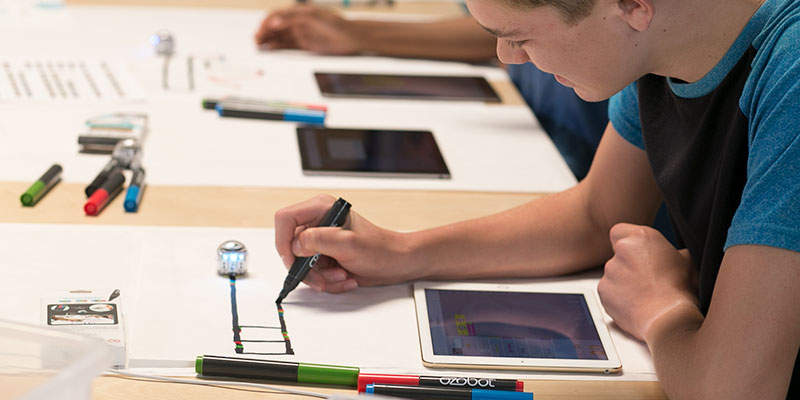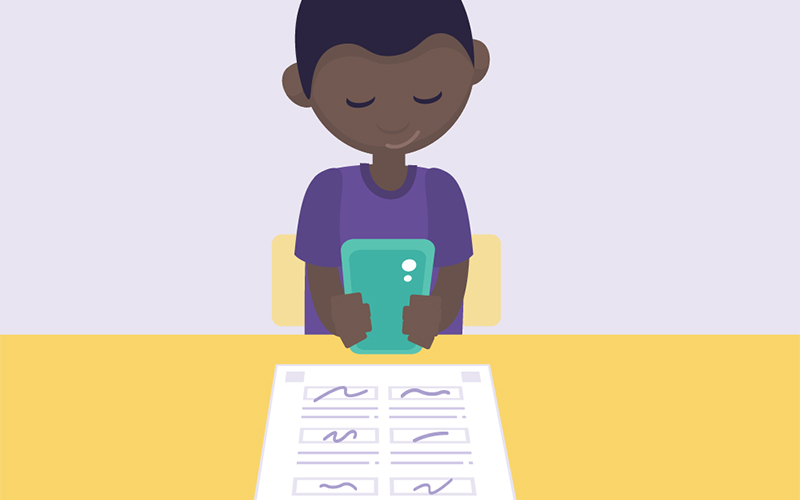Updated for 2025: Since this post was first written, the education landscape has changed greatly! We’ve updated it to include more tech tools teachers can use to inspire creativity in the classroom for virtual learning.
As technology continues to evolve, educators have access to an ever-expanding array of tools designed to foster creativity and engagement among students. In 2025, artificial intelligence (AI) and immersive technologies have become integral to the educational landscape, offering innovative ways to enhance learning experiences. Building upon our previous compilation, here are some of the latest tech tools that educators can incorporate to inspire creativity in their classrooms:
AI-Powered Educational Platforms
AI-driven platforms analyze individual student needs, strengths, and learning styles to provide personalized learning experiences. These tools offer adaptive content, recommend resources, and deliver real-time feedback, allowing students to progress at their own pace while fostering creativity through customized learning paths.
Popular examples:
- Knewton Alta – Uses AI to create personalized learning paths for students based on their performance and learning styles
- DreamBox Learning – Adapts in real-time to student interactions, providing just-right challenges that build confidence and competence
- Century Tech – Creates personalized learning pathways using AI to identify knowledge gaps and recommend targeted content
Video Generative AI Tools
Video generative AI tools enable educators and students to create dynamic, customized, and high-quality visual content. These tools support authentic task design, enhance teaching strategies, and boost student engagement by allowing learners to produce creative video content that aligns with their learning objectives.
Popular examples:
- Synthesia – Creates professional-looking educational videos from text scripts with AI avatars
- InVideo AI – Transforms lesson plans into engaging visual content with minimal technical expertise required
- Runway – Offers advanced video editing capabilities powered by AI, allowing students to create professional-quality projects
Virtual and Augmented Reality (VR/AR) Experiences
Immersive technologies like VR and AR have become more accessible, allowing students to embark on virtual field trips, explore historical sites, or interact with 3D models. These tools provide interactive and engaging learning experiences that stimulate creativity and curiosity.
Popular examples:
- Avantis VR Headsets – Classroom-ready devices that have gained widespread adoption in U.S. schools
- Merge Cube – Affordable AR technology that lets students hold digital 3D objects in their hands
- Google Expeditions – Now integrated with enhanced spatial audio and haptic feedback for more immersive virtual field trips
- ARCore Classroom – Google’s expanded AR platform with educator-focused features for creating custom AR experiences
Interactive Game-Based Learning Platforms
Game-based learning platforms enable educators to create interactive, game-like lessons using any content. These tools transform traditional lessons into engaging learning experiences, encouraging creativity, critical thinking, and problem-solving skills among students.
Popular examples:
- Deck.Toys – Creates interactive learning adventures from any curriculum content
- Kahoot! Scenarios – The popular quiz platform’s new feature for creating branching, narrative-driven learning games
- Classcraft 2.0 – Gamifies classroom management with RPG elements and new accessibility features
- Minecraft Education Chemistry Lab – Expanded tools for teaching STEM concepts through creative building and experimentation
Collaborative Digital Whiteboards
Integration of collaborative digital whiteboards facilitates brainstorming and group work. These tools allow students to collaborate in real-time, share ideas, and engage in creative problem-solving activities, enhancing the overall learning experience.
Popular examples:
- FigJam for Google Classroom – Seamless integration with Google’s education suite
- Miro Education – Interactive whiteboard platform with expanded education-specific templates
- Explain Everything – Combines whiteboarding with screen recording for asynchronous collaboration
- ConceptBoard Classroom – Infinite canvas with new structured collaboration features for classroom projects
AI Tools for Special Education
AI technology is making strides in special education by tailoring resources to individual needs, simplifying information, and enriching educational experiences for students with intellectual and developmental disabilities (IDD). These inclusive AI tools promote creativity and ensure equitable learning opportunities for all students.
Popular examples:
- Speechify EDU – Text-to-speech technology with new features specifically designed for learning disabilities
- Claro Read – Screen reader with advanced customization options for diverse learning needs
- Livescribe Symphony – Smart pens with improved integration with accessibility software
- Microsoft Learning Tools – Expanded capabilities with personalized reading and writing support
AI-Enhanced Learning Management Systems
Modern LMS platforms now incorporate AI to streamline administrative tasks, provide insights on student performance, and offer personalized learning recommendations, freeing teachers to focus on creative instruction.
Popular examples:
- Canvas Intelligence – Advanced analytics and predictive tools to identify at-risk students
- Blackboard Ultra AI – Automated grading with detailed feedback suggestions
- Schoology Smart Assignments – Content recommendations based on student progress and learning objectives
- D2L Brightspace Insights – Comprehensive learning analytics with actionable recommendations
Data Visualization and Analysis Tools
Tools that help students understand and create compelling visualizations of data, enhancing both literacy and creative expression.
Popular examples:
- Tableau for Education – Professional-grade visualization with expanded educational resources
- Flourish Classroom – Interactive data storytelling platform with student-friendly interface
- DataWrapper Education – Simple tool for creating professional charts and maps
———————————————————————————————————————————————————————
Virtual Learning Tools
The shift to remote learning had many teachers scrambling to find effective ways to share lessons, deliver instruction, and allow students to collaborate. Here are some of our favorite tools to get online/hybrid classes running effectively:
Ozobot 1:1 Program | Evo Student Packs
With the shift to remote learning, we knew we needed to work with districts, teachers, and our extended community to understand education’s new challenges. The result is our 1:1 Robotics Program, designed for teaching core subjects anywhere without sacrificing STEAM. Each student receives a Student Pack—a care package from you to them—to make core subjects more hands-on and collaborative with their robot study buddy using our 2 Ways to Code. Plus, we made Ozobot Classroom remote-friendly, including a seamless Google Classroom integration and Learn Anywhere Lessons that can be used virtually or back in the classroom.
More good news: Ozobot qualifies for federal and state initiatives (CARES Act, 21st Century Schools etc), making 1:1 possible for educators nationwide. Sign up for a personal demo to learn more and see how we can be part of your K-12 solution to keep students engaged in class or at home.
Buncee
Buncee understands how much more kids learn if they’re engaged, so their platform makes it easy to engage students from anywhere. Teachers have the flexibility to create activities that their class will enjoy with over 1000 templates, and students earn badges as they complete their work. Buncee also makes it easy for students to collaborate with sharing and discussion functionality.
Bakpax
Bakpax is an AI tool that autogrades student work, giving them (and the teacher) instant feedback on assignments! As teachers know, hand grading student work can take hours, so Bakpax allows teachers to save time with the more administrative aspects of teaching, so they can focus more on creative lessons/activities and individualizing student instruction.
Bakpax wants to support educators during the transition to remote learning, so teachers can currently access Bakpax for free!
Pear Deck
Pear Deck allows teachers to make lessons interactive so every student can actively participate, whether instruction is synchronous or asynchronous. It utilizes formative assessment, active learning, retrieval practice, and more to close the achievement gap, even for students who are learning from afar. Bonus: PearDeck has the stamp of approval from many Ozobot Certified Educators.
SeeSaw
Rather than limit students to one method for demonstrating their knowledge, SeeSaw allows students to show what they know with tools like draw+record, collage, video, and more. Educators report that SeeSaw is intuitive for students to use, so minimal support is required to use this tool!
For more tips on creating successful virtual learning environment, check out our Ozobot Certified Educator-hosted webinar!
Original post by Amanda Dodge:
Students who grow up with a love of learning are more likely to stay engaged in STEAM subjects and other lessons as they grow older. They won’t take what they learn at face value, and will instead seek out ways to expand their knowledge and ask questions about what they learn.
Teachers are always looking for ways to pique student interest, from engaging experiments to unique learning methods. If you want to add fresh elements to your classroom and encourage your students to be creative, check out these tools. They might offer the tech solutions you need to wow your students during the learning process.
Evo Classroom Kit
We may be a little biased, but our personal favorite tool is the Evo Classroom Kit. This kit is made for students grades 4 through 8 and includes 12 Evos, accessories, and a driver’s ed activity that allows students to program Evo’s proximity sensors and other features. Plus, students and educators can explore over 100 STEAM lessons in the Lesson Library. Lessons cover a wide range of subjects along with Ozobot’s two ways to code—online with OzoBlockly and screen-free with Color Codes. Teachers across the country have shared how they use their Classroom Kits to encourage creativity while teaching coding concepts. We pride ourselves on fostering a creative experience that motivates students to keep learning.
Nearpod
Nearpod specializes in multimedia displays to make discussions more engaging. One of their top tools for teachers is Nearpod VR, an affordable virtual reality headset that lets teachers explore different concepts in 3D. There are more than 450 VR tutorials, broken down by subject and grade level. Take your students to explore volcanoes or for a historic look at the Taj Mahal. This technology inspires curiosity about the world and student engagement in lessons.
Learn Around The World
The goal of Learn Around the World is to use technology to connect students and educators globally. They have events and collaborative projects where students can work with people in different countries, and virtual field trips for exploring foreign lands. LATW also has guest speakers and private events that teachers can take advantage of. Imagine speaking with someone who lives in Buenos Aires while learning about Argentina. Your students can ask questions and use their curiosity to spur discussion.
Buncee
Never sit through boring Powerpoint presentations again with Buncee, a multimedia display tool that allows students to easily create displays and narrate them through microphone recordings. There are more than 8,000 graphics to choose from and students can upload their own media as well. They can either create a presentation based on their own findings or use Buncee’s tools to add graphics to their ideas. This is also a useful tool for students who might be too young for Powerpoint tutorials.
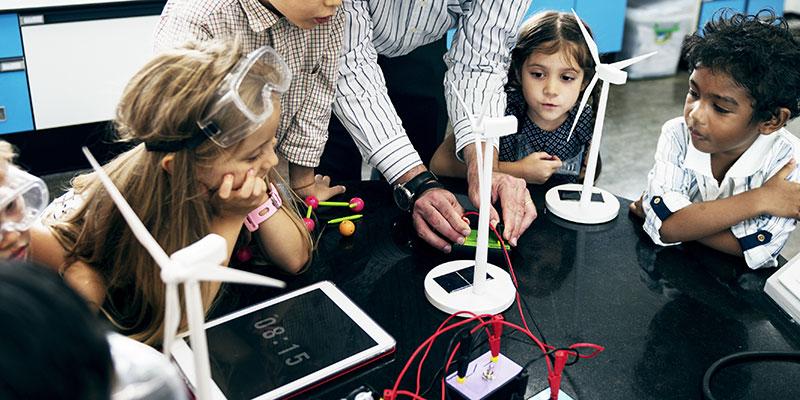
Glogster
Glogster is one of the fastest-growing multimedia management tools for teachers and students. Your students can easily create posts and other graphic designs to enhance their learning experience. This site also allows teachers to find awesome content. There are more than 40,000 Glogs shared online across 80 topics and nine disciplines. With over 1.9 million teacher accounts and 17 million student accounts, Glogster is a favorite worldwide.
FlipGrid
Do you wish classroom discussion could continue after the bell rings? Do you wish you could encourage quiet students to speak their minds without feeling intimidated? With FlipGrid, teachers create discussion topics and students can respond with video recordings. Their peers can respond to keep the discussion going. This tool helps students formulate their ideas in a pre-recorded setting, which means no one gets talked over or ignored by louder voices.
TodaysMeet
TodaysMeet provides a backchannel of discussion for your classroom. Teachers monitor chat discussions during the lessons and can respond to or highlight questions asked by students as they go. Instead of stopping the class or losing your train of thought to answer questions, teachers can set aside time for questions and discussion at various points throughout. Plus, quiet students can ask questions and voice their opinions without having to worry about speaking up or waiting until the end.
Microduino
Microduino offers small electronic building blocks that kids can creatively assemble to find solutions to problems or explore ideas. These blocks can be stacked on LEGO bricks, expanding your resources as far as your imagination will go. This product also has open-source code compatible with Scratch and other programs you might already use.
TinyTap
TinyTap is home to more than 100,000 learning activities for students and teachers to use. You can search for games for your kids to play to better help them understand concepts, or ask them to create games of their own. TinyTap Market encourages students to learn by teaching, and provides the tools to help people develop their own games. Creators can even sell their games to gain recognition for their work.
Because Learning
This tool is ideal for teachers who want to bring STEAM learning to the classroom but worry about their lack of programming background. You don’t have to be a professional web developer to engage your students. Because Learning is designed for educators and offers STEAM kits based on national learning standards. You and your students can start creating in just a few steps.
SiLAS Solutions
More instructors are increasingly concerned with social skills and encouraging their students to work together. SiLAS Solutions is a tool that can help. Through video game technology and 3D development, students use characters and create conversations with their own voice recordings. They can make videos talking through problems and expressing their emotions. Grading is easy, with teachers able to assess students and provide feedback through the system.
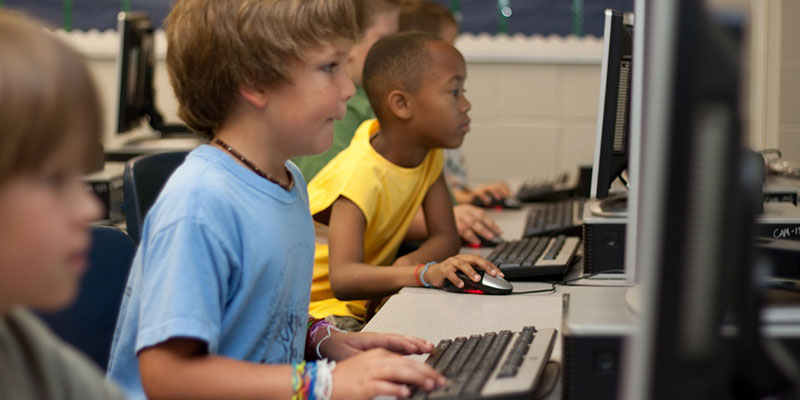
Labster
Do you wish you had access to a University-calibre laboratory? Consider testing simulations with Labster. Students can run a variety of simulations on topics ranging from diabetes to herpetology. The software runs mathematical algorithms based on the criteria so students get a full lab experience. Teachers can grade participation in different parts of the simulation as they would with a full-fledged science lab.
PhET Sims
Another simulation software that younger students can use is PhET simulations. Teachers can filter simulations by grade level and topic and use them to explore different ideas in the classroom. The goal of this organization is to increase STEAM literacy worldwide and create engaging interactive content that encourages students to ask questions and explore topics beyond what the common core demands.
ZeeMaps
ZeeMaps is a tool that students and teachers can use to create their own graphics. You can create maps on a local, state, national, and even global level. Students can choose different map types and assign colors and labels as needed. This is perfect for creating visual aids for projects, mapping out complex concepts (like battles in a war or evolving country borders), and letting students learn in an interactive manner.
Tiki-Toki
Just as ZeeMaps is useful for mapping out various concepts and ideas, Tiki-Toki is great for developing timelines. Students can customize events and choose different formats to explore their ideas. They can provide as much information as they need to fully explain a topic. This tool is ideal for both classroom-led activities and solo work.
Popplet
Popplet is a mind-mapping and brainstorming tool for students. You can use this tool to guide assignments, encouraging students to create mind maps for their projects, or create a classroom-guided brainstorm to explore new ideas. This tool is also used in group projects to help students creatively come up with solutions to problems. It teaches the concept of brainstorming and has a useful option to save your ideas for later.
Venngage
You don’t need to be an expert graphic designer to create engaging infographics for your classroom. Even better, your students can create graphics for you! Venngage offers free infographic tools to help students visualize their data and clearly present ideas. The infographics can be shared and saved online, so they can be used by students in real time and future students can also benefit.
Sutori
Sutori lets anyone build a multimedia-rich story that looks like a timeline, though the focus is on arranging information into an engaging, interactive format for storytelling. It’s a useful format, too, because it’s a more intuitive way to illustrate the relationships between concepts than, say, a slidedeck. The applications are many, as well: Teachers can use pre-made stories in their lesson plans (there are nearly 800,000 users, so stories are plenty), or they can create their own stories in a snap to use as teaching tools or study aids. What’s more, stories can even be assigned as projects or homework, which could be a welcome alternative to an essay assignment.
Lifeliqe
With more than 1,100 3D models and 700 lesson plans, Lifeliqe provides an interactive way to meet Common Core and Next Generation Science Standards. This tool has data behind its name: 86 percent of students who used their 3D models to learn improved their science scores. The company attributes their success to the idea that 65 percent of the population is made of visual learners. By connecting with kids in the way they learn best, they’re more likely to enjoy the material.
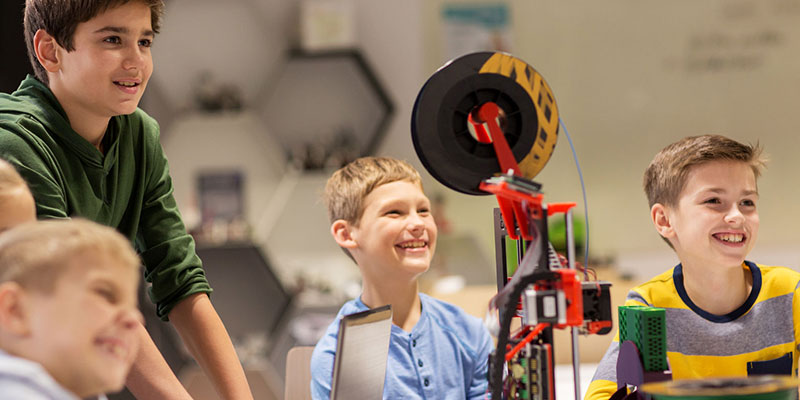
Storybird
STEAM educators who are looking to add reading and writing elements to their curriculum can try Storybird. This company curates millions of images from illustrators across the world and encourages students and teachers to use them to tell stories. Consider assigning an image to each student and asking them to write about it, or ask them to create a book using the lessons they learned in science or math class. It’s a great way to get creative with online tools.
KidBlog
If you’re trying to get your students to blog more and reflect on what they learned, consider using Kidblog. Nothing goes live until the teacher approves it, so you have final say in what is published. KidBlog creates a safe space for students to publish content without exposing them to the trolls of the Internet. It’s available for K-12 students and you can tailor your lessons based on the age group. You can also track engagement statistics each year to see if your students are reading each other’s work.
LiveBinders
The goal of LiveBinders is to help educators and their students go paperless with digital binders. Users can save articles and videos, take notes, and post other forms of content in one place. They can also share binders with each other and collaborate to create something useful. With this tool, you never have to limit yourself to just one textbook or resource. You can keep all of your resources in one place for years to come, always adding when you find something new.
Padlet
Padlet is another collaboration tool that teachers can use. Students can submit a variety of supplemental material to make the learning process easier and can comment and interact with it as needed. Teachers can monitor all interactions that students have with the content and track engagement analytics. This tool can be used for any subject or grade level.
Celestia
This tool is definitely more space-focused instead of the other one-size-fits-all solutions on this list. However, it’s rare to find such a dynamic resource for exploring outer space. Not only is there a wide variety of content on Celestia, but students and educators can customize the content or add their own based on their needs. If there’s something you can’t find, create it.
Project Noah
Launched in 2010, Project Noah was created to encourage citizen scientists to document the world around them. People can photograph organisms and share them online, helping scientists document the location and rarity of various species. Teachers can make this part of the classroom experience by turning students into citizen scientists sharing their discoveries.
Science360 Video Library
One of the biggest challenges that teachers face is modernizing the classroom and making students care about what they’re learning. Part of the National Science Foundation, the Science360 Video Library shares the latest videos related to science, technology, and engineering. Whether you’re introducing students to outer space discoveries or explaining undersea exploration, you can update those lessons with this video collection.
Teachers TryScience
If you’re uncertain where to start with science and STEAM lessons, check out Teachers TryScience. Teachers can find lesson plans and follow different strategies and tutorials to make their content more engaging. It can be intimidating giving students the keys to explore a particular topic, but this site makes it easier.


